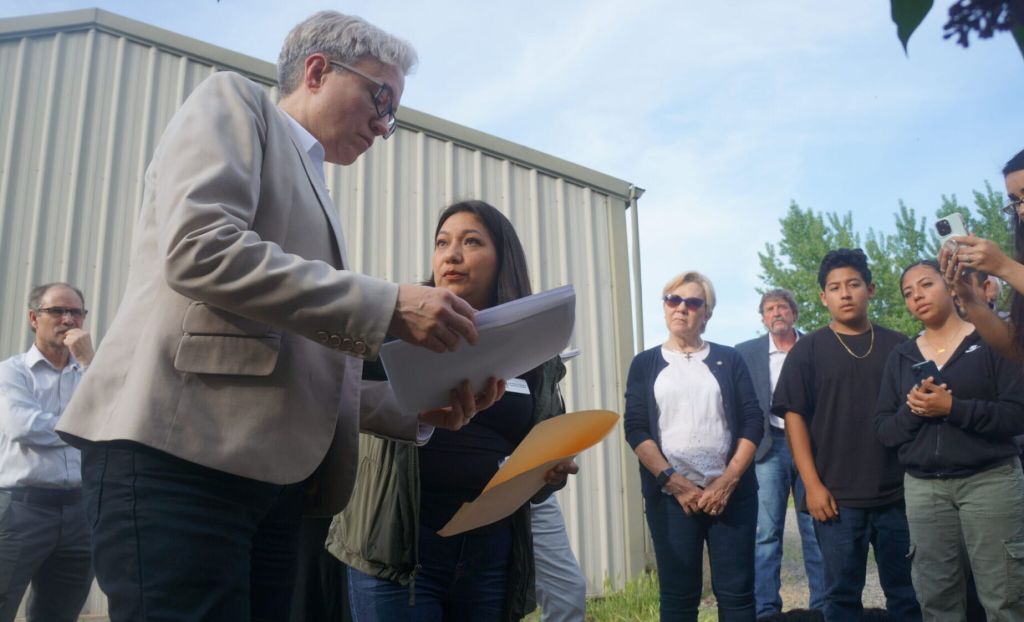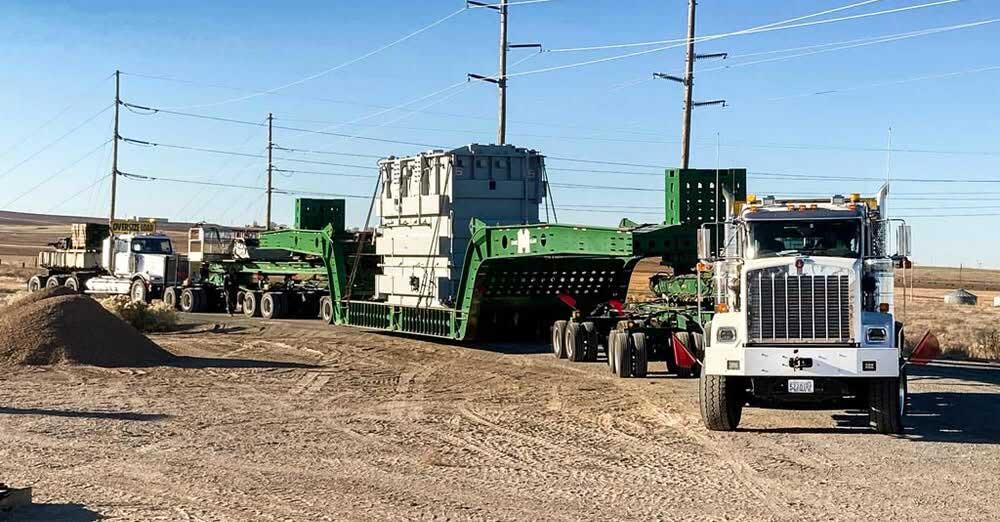Opposition packs hearing on Gov. Kotek proposal to update critical groundwater area protections
Published 1:00 pm Wednesday, April 9, 2025

- Gov. Tina Kotek on May 3, 2023, visits the home of Ana Maria Rodriguez, a Boardman resident and Oregon Rural Action organizer, whose well water has nearly four times the safe drinking water limit for nitrate. Kotek approved wastewater land application by the Port of Morrow Jan. 13, 2025, to avoid a shutdown of the local economy.
More than 500 letters of testimony oppose Senate Bill 1154, largely from people who fear it will let state agencies take their well water
SALEM — Gov. Tina Kotek’s proposal to give state agencies more authority to intervene earlier in Oregon’s contaminated groundwater areas met massive opposition at its first public hearing.
Two rooms and two separate hearings were scheduled Tuesday, April 8, to accommodate all of the people who went to the Capitol to offer testimony on Senate Bill 1154 during a meeting of the Senate Natural Resources and Wildfire Committee. The bill was sent to the Senate Rules Committee without recommendation, where it will receive another public hearing in the weeks ahead.
Bill advocates say it would provide much-needed updates to the state’s Groundwater Quality Protection Act first passed in 1989. That act was meant to conserve groundwater resources and prevent contamination following well-testing across the state that showed many contained water with high levels of agricultural chemicals.
Chandra Ferrari, Kotek’s natural resources adviser, told lawmakers the current law is too vague, lacks a clear process for involving state and local agencies in remediating pollution and doesn’t do enough to protect groundwater from pollution before aquifers become critically impaired.
About 80% of Oregonians rely on groundwater for some or all of their drinking water, and one-quarter rely on private, at-home wells. About 90% of rural Oregonians rely on those at-home wells, according to Ferrari.
“It’s risky, it’s costly, it’s time-consuming to not effectively address contamination,” Ferrari told lawmakers. “We need to work harder to not hit these critical contamination thresholds, and we need to work smarter when we do. Our laws should facilitate us doing these things well.”
But those opposed to the updates include more than 560 people and groups who submitted testimony in advance of the hearing, as well as several Eastern Oregon state representatives, who say the bill would allow state agencies broader authority to do water and soil testing and monitoring on private property without landowner consent and that it could lead to state agencies cutting off water to some.
State Reps. Bobby Levy, R-Echo, and Greg Smith, R-Heppner, spoke in opposition to the bill at the hearing .
Smith said allowing state agencies to monitor and test private wells, or inspect potentially leaky septic systems, would violate his constituents’ property rights.
Levy called it an “unacceptable overreach of state power,” and a “persecution” of rural Oregonians.
“It grants broad, unchecked authority to state agencies, allows them to walk onto private property, dig up soil, impose arbitrary restrictions and suspend water use that is critical, not only to agriculture, but to basic human life,” she said, before applause erupted in one hearing room.
What the bill does
The updated Groundwater Quality Protection Act would establish thresholds for contaminants that automatically qualify them as critical groundwater management areas. It would also create a new designation for “groundwater areas of concern,” where contaminants are detected but a threshold for declaring the area in critical condition hasn’t quite been met.
The five governor-appointed members of the Oregon Environmental Quality Commission would designate “areas of concern” if contamination was growing or particularly threatening, and then the governor would appoint a response team made up of a mix of agency officials who would help local stakeholders create a “local voluntary implementation plan” for curbing pollution and alerting the public.
The groups and agencies would be required to provide regular reports to the Environmental Quality Commission, the governor and the Legislature in order to receive funding to execute their local voluntary implementation plan.
If the voluntary plan does not keep a basin from entering critical contamination thresholds, then state agencies could more directly intervene, including testing soil and water on private land for potential septic leaks and requiring some wastewater permit holders to conform to tighter regulations on where and how much nitrate-laden water they can release.
The bill also more clearly spells out which agencies are responsible for participating in action on groundwater management areas and what each agency is responsible for doing.
The Oregon Health Authority would be in charge of informing the public and helping with testing and providing safe drinking water; the Oregon Water Resources Department would be in charge of regulating water flows and rights; the Oregon Department of Agriculture would take on agricultural polluters and mitigating farm pollution; the Oregon Department of Environmental Quality would take on any changes needed to protect groundwater through industrial water permitting; and other agencies would be involved as needed, according to Ferrari.
As the law works now, there isn’t one sole agency responsible for groundwater quality protection in Oregon, Ferrari said, and no single agency is responsible for helping communities impacted by contaminated groundwater.
Decades-long problems
Since 1989, three critical groundwater management areas have been identified in Oregon. They are all still considered to be in critical condition due to nitrate contamination, almost entirely from agriculture, and none have seen vast improvement in the last two to three decades.
The Lower Umatilla Basin Groundwater Management Area in Northeastern Oregon, designated as critically impaired in 1990, has gotten worse under state supervision, and a volunteer committee established in 1997 to tackle problems has had little to no impact.
Thousands of residents in Morrow and Umatilla counties — mostly Latino and low-income — have lived and drunk from contaminated wells, which is dangerous because nitrates consumed over long periods can increase risks for cancer and birth defects. In September, Kotek and state agency officials released a comprehensive plan for curbing nitrate pollution in northeast Oregon that “will take decades” to achieve.
More than a dozen residents of Boardman who cannot drink their well water submitted testimony in support of Senate Bill 1154.
Kaleb Lay, director of policy research at the nonprofit Oregon Rural Action, said the bill could be improved in the Senate Rules Committee to get broader buy-in, but updates to the Groundwater Protection Act are long overdue. It wasn’t until Morrow County declared a water emergency and Oregon Rural Action began a grassroots well testing campaign that the state became more directly involved.
“If we leave the law unfixed, it will simply stay broken. I would argue that every moment we spend on this bill is worthwhile,” Lay told lawmakers.
Ferrari said updates to the Groundwater Quality Protection Act would allow the state to intervene earlier to avoid situations such as that in the Lower Umatilla Basin.
“We know or have reason to believe there are contamination problems in other parts of the state that are not currently GWMAs (groundwater management areas),” she told lawmakers. “And also, we are still in the process, 30-plus years later, of undertaking costly and time consuming efforts to address contamination in the GWMAs that have been identified.”
———
Oregon Capital Chronicle is part of States Newsroom, a nonprofit news network supported by grants and a coalition of donors as a 501c(3) public charity. Oregon Capital Chronicle maintains editorial independence. Contact Editor Lynne Terry for questions: info@oregoncapitalchronicle.com. Follow Oregon Capital Chronicle on Facebook and X.





